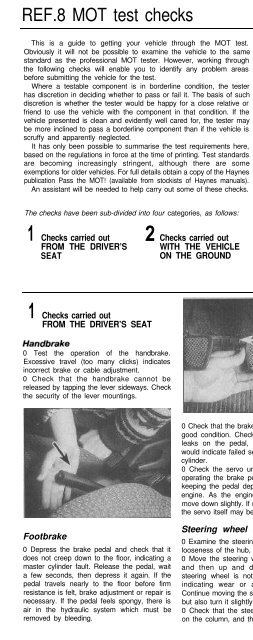Contents - Volkspage
Contents - Volkspage
Contents - Volkspage
You also want an ePaper? Increase the reach of your titles
YUMPU automatically turns print PDFs into web optimized ePapers that Google loves.
REF.8 MOT test checks<br />
This is a guide to getting your vehicle through the MOT test.<br />
Obviously it will not be possible to examine the vehicle to the same<br />
standard as the professional MOT tester. However, working through<br />
the following checks will enable you to identify any problem areas<br />
before submitting the vehicle for the test.<br />
Where a testable component is in borderline condition, the tester<br />
has discretion in deciding whether to pass or fail it. The basis of such<br />
discretion is whether the tester would be happy for a close relative or<br />
friend to use the vehicle with the component in that condition. If the<br />
vehicle presented is clean and evidently well cared for, the tester may<br />
be more inclined to pass a borderline component than if the vehicle is<br />
scruffy and apparently neglected.<br />
It has only been possible to summarise the test requirements here,<br />
based on the regulations in force at the time of printing. Test standards<br />
are becoming increasingly stringent, although there are some<br />
exemptions for older vehicles. For full details obtain a copy of the Haynes<br />
publication Pass the MOT! (available from stockists of Haynes manuals).<br />
An assistant will be needed to help carry out some of these checks.<br />
The checks have been sub-divided into four categories, as follows:<br />
1 Checks carried out 2 Checks carried out<br />
FROM THE DRIVER’S<br />
SEAT<br />
WITH THE VEHICLE<br />
ON THE GROUND<br />
3 Checks carried out 4 Checks carried out on<br />
WITH THE VEHICLE<br />
RAISED AND THE<br />
WHEELS FREE TO<br />
TURN<br />
YOUR VEHICLE’S<br />
EXHAUST EMlSSlON<br />
SYSTEM<br />
1 Checks carried out<br />
FROM THE DRIVER’S SEAT<br />
0 Test the operation of the handbrake.<br />
Excessive travel (too many clicks) indicates<br />
incorrect brake or cable adjustment.<br />
0 Check that the handbrake cannot be<br />
released by tapping the lever sideways. Check<br />
the security of the lever mountings.<br />
0 Check that the brake pedal is secure and in<br />
good condition. Check also for signs of fluid<br />
leaks on the pedal, floor or carpets, which<br />
would indicate failed seals in the brake master<br />
cylinder.<br />
0 Check the servo unit (when applicable) by<br />
operating the brake pedal several times, then<br />
keeping the pedal depressed and starting the<br />
engine. As the engine starts, the pedal will<br />
move down slightly. If not, the vacuum hose or<br />
the servo itself may be faulty.<br />
movement of the steering wheel, indicating<br />
wear in the column support bearings or<br />
couplings.<br />
Windscreen and mirrors<br />
0 The windscreen must be free of cracks or<br />
other significant damage within the driver’s<br />
field of view. (Small stone chips are<br />
acceptable.) Rear view mirrors must be<br />
secure, intact, and capable of being adjusted.<br />
Footbrake<br />
0 Depress the brake pedal and check that it<br />
does not creep down to the floor, indicating a<br />
master cylinder fault. Release the pedal, wait<br />
a few seconds, then depress it again. If the<br />
pedal travels nearly to the floor before firm<br />
resistance is felt, brake adjustment or repair is<br />
necessary. If the pedal feels spongy, there is<br />
air in the hydraulic system which must be<br />
removed by bleeding.<br />
Steering wheel and column<br />
0 Examine the steering wheel for fractures or<br />
looseness of the hub, spokes or rim.<br />
0 Move the steering wheel from side to side<br />
and then up and down. Check that the<br />
steering wheel is not loose on the column,<br />
indicating wear or a loose retaining nut.<br />
Continue moving the steering wheel as before,<br />
but also turn it slightly from left to right.<br />
0 Check that the steering wheel is not loose<br />
on the column, and that there is no abnormal

















